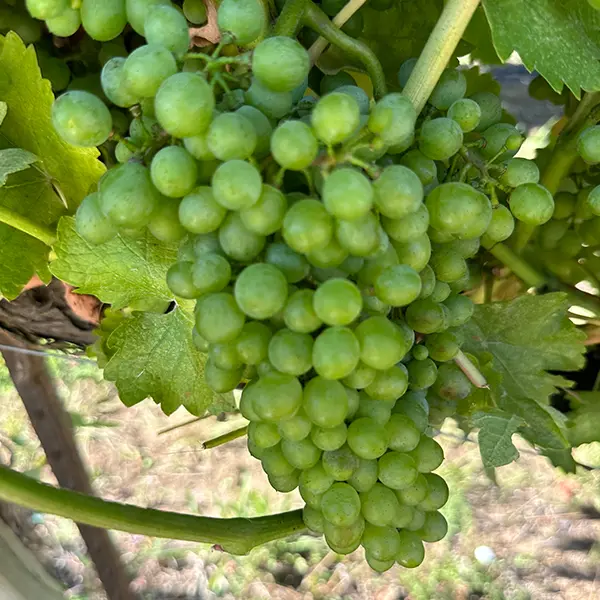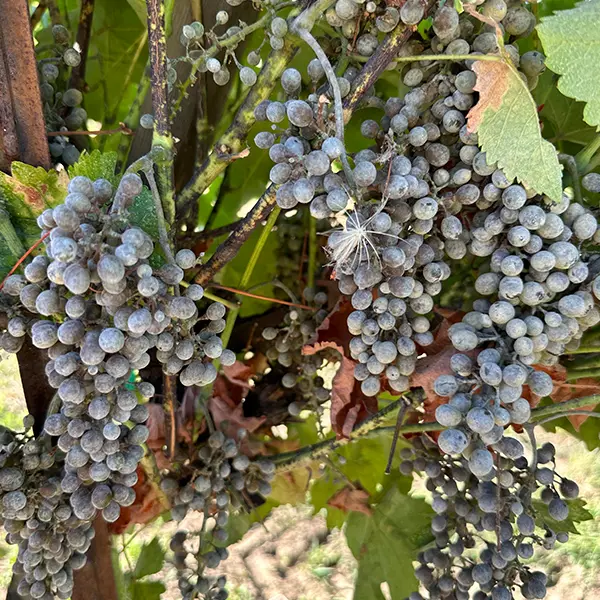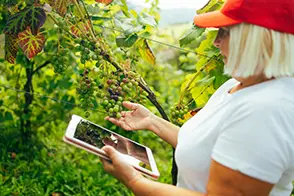Proactive IPM Strategy puts Wine Growers Ahead of Disease and Pest Pressures
For the Wilbur-Ellis team working with wine growers in California, integrated pest management (IPM) is part of each day’s work. IPM is the foundation of a strategic approach they employ to control crop pests while delivering on the grower’s longer-term goals—Sustainable, Organic, Natural or Biodynamic—whether an estate winery or a grape grower.
The strategy focuses on preventing diseases or pest damage using a combination of biological controls, habitat management, cultural practices and resistant varieties. Pesticides are used following specific guidelines and only after field scouting shows they are needed. Products are chosen and applied in a way that minimizes risks to human health, beneficial and nontarget organisms and the environment.
IPM strategy is built upon deep historical knowledge.
“Our goal is to provide recommendations that deliver return on investment for our customers,” says Armon Azevedo, viticulture pest control adviser, located near Windsor, California. “Our secret sauce is the decades of historical knowledge we have on many of these properties throughout California, the data we collect each year and our behind-the-scenes work, analyzing and measuring performance.”
The Wilbur-Ellis team combines this knowledge with the customer’s goals, considering the grower’s farming system and ability to implement recommendations.
The issues prevalent for specific varieties as well as expected weather influences also are part of the mix when developing recommendations for the right cultural practices and the right products—from organic to conventional—to be used at the right time and right rate.
Disease prevention is a key strategy in IPM.
Diseases are the most difficult pest to manage, and vines are particularly prone to disease if there was an infection the previous season. In early spring, (typically March) Wilbur-Ellis viticulturists begin reviewing the history of each block to confirm if economic thresholds required treatment in the past.
These experts also inspect vines during the winter for signs of overwintering diseases or insects. Signs could include wood staining or left over residue from insect secretions. In certain parts of the wine-growing region, the team also looks for signs insects are emerging before bud break.
“We make it a priority to get into the blocks to look for visible signs of infection,” explains Azevedo. “If we have underperforming, discolored vines or poor growth during the winter, we know it’s time to do virus testing to determine if the vines are dealing with viruses, nematodes or other soil pathogens or pests.”
Variety and environment are considerations in formulating a proactive IPM approach.
Different varieties are more susceptible to some diseases. For example, Chardonnay is particularly susceptible to mildew. If the vines were infected the previous year, Azevedo may recommend starting with a sanitation spray, either an oil or a wettable sulfur near bud break, to sanitize those vines and reduce the potential for an overwintering virus to manifest infection.
“In the spirit of IPM, we work to do no harm,” Azevedo says. “Prevention is always better than trying to implement a cure. So, we begin with tactics we can use to mitigate or minimize pest pressure.”
Weather also has a significant impact on disease pressure. While the incidence of fungal diseases was low in 2020-2022 due to drought, with rain in 2023, incidence increased.
Azevedo also considers that cooler, more humid areas are sweet spots for disease growth. There will be a higher potential for Botrytis and mildew as the vines produce vegetative growth and the temperatures warm up from April until July.
Various tactics are deployed for different challenges.
Cultural practices often trump the use of products to overcome pest challenges. For example, in a young block plagued with red blotch or leaf roll virus, if the occurrence is less than 25%, the disease spread can be prevented by rouging out diseased vines. Often diseases are spread from plant to plant by insects.
“Leaf roll is a disease spread by all mealybugs, so preventing mealybug infestations will help maintain the health of the vines,” Azevedo adds. “We employ a variety of strategies from beneficial insects to conventional chemistries to mating disruption pheromones to control mealybugs.”
Optimizing their effectiveness of the beneficial insects also requires strategic control of other insects such as ants that attack beneficial insects.
“The ants thrive on honeydew produced by mealybugs, so ant control is critical, and it’s challenging, especially in an organic farming system where we must work within the guidelines of organic certification,” says Azevedo.
Decades of historical knowledge on many vineyards throughout California help Wilbur-Ellis viticulturalists proactively protect susceptible varieties like Chardonnay from mildew and other pests.
Organic requires a more proactive approach to IPM.
Softer chemistries and the use of strategies such as beneficial insects common in organic production require more proactive steps, and the team builds their approaches with that in mind. Historical knowledge, scouting and being well-informed on the latest products and practices for organic production are foundational for success.
“With your organic products, we may get 7 to 14 days of control depending on disease pressure,” Azevedo says. “We have to weigh the duration and effectiveness of the product, and then the cost of re-treatment. We couple those factors with growth stage, pest pressure and what the weather’s doing. It’s a risk-management thought process, and there’s more to consider.”
Practicing good vineyard sanitation by limiting movement between infected and non-infected blocks, thoroughly power-washing equipment and sanitizing tools, and properly handling and disposing of infested pomace piles or cluster stems is also critical for disease prevention and management.
Technology aids in executing IPM effectively and according to regulatory guidelines.
Azevedo and others on the Wilbur-Ellis team also incorporate technology, using AgVerdict. This Wilbur-Ellis exclusive, fully integrated precision farming solution delivers a toolkit of services from season-long planning and record keeping to product use reporting, field mapping, nutrient management and stewardship plus much more. With AgVerdict at their fingertips, growers and agronomists may precisely manage each block, field and farm, comparing year-over-year challenges, solutions and outcomes.
Wilbur-Ellis agronomists also turn to AgVerdict for its database of product, rate and application specifications as they write recommendations. This ensures they’re making safe, legal recommendations, so growers have the necessary records and freedom to operate and sell their product.
“By having an accurate record of acres and row spacings that we keep in AgVerdict, we’re also able to ensure that we’re sending them the right amount of material, so they know that they’re not overbuying or under buying,” he adds.
The Wilbur-Ellis IPM strategy focuses on preventing diseases or pest damage using a combination of biological controls, habitat management, cultural practices and resistant varieties. Pesticides are used only after field scouting shows they are needed.
Continued learning is a sustainable aspect of IPM at Wilbur-Ellis.
Members of the Wilbur-Ellis team pride themselves in continual learning, providing their customers with effective solutions and a competitive edge.
“Our IPM learning is ongoing. We immerse ourselves in the results of university trials that compare new products with mature products,” Azevedo explains. “And we challenge manufacturers to provide us with trial plots so we can see how the latest products will work in our area, because the best information is in local data.
“We also hold monthly IPM training meetings for our team where we compare notes and share experiences with products used in other geographies before we recommend products to our growers,” he adds.
To visit with a Wilbur-Ellis viticulturist for IPM strategies for your vineyard, call or stop by your local Wilbur-Ellis location.





